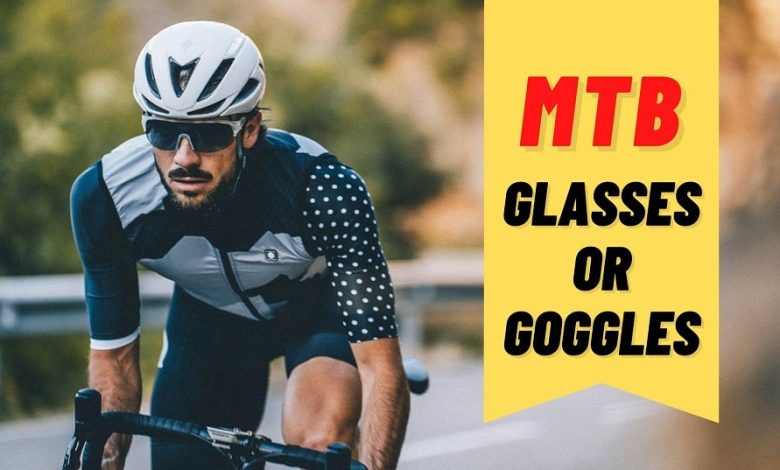MTB glasses or goggles? Find out which is the best alternative for you

A basic element in a cycling ride, whatever the modality or discipline you practice, is the protection of your eyes. As we get into mountain biking with big wheel mongoose bike or others, the question begins to arise as to what is best for us: if glasses or goggles.
In this article, you will find the advantages and disadvantages of both so that in the end, you choose the alternative that best suits your needs and thus protect your eyes while practicing MTB.
Importance of protecting our eyes in cycling
In any shoot you participate in, you will be asked to wear glasses to protect your eyes. In addition to the impact of ultraviolet rays, it is important to protect yourself from the air and from possible garbage or insects that may fall into your eyes. As you develop more speed in cycling, these particles are more likely to hit your face, get into your eyes, and cause an accident by momentarily blocking your vision.
It is important to emphasize that not all glasses are an option for cycling in general. For example, metal frames or frames are a danger to our physical integrity, as they can break and injure our face, even our eyes since metal is exposed and is a sharp material. For this reason, in most events, competitions, etc., they recommend wearing plastic frames. Keep reading best sunglasses for cycling.
MTB glasses or goggles
Find out which is the best alternative for you. A lot of people use either, but when it comes to performance and protection, there’s a definite winner. Goggles offer a number of advantages that glasses do not: they block more dirt and debris from getting into your eyes; they seal out the wind, and they’re better in foul weather. That said, goggles can fog up both in dry and wet conditions.
Goggles:
Why do you need goggles for mountain biking? They protect your eyes when you are riding, they keep the bugs out of your eyes, they keep the sweat off your face and goggles react better in bright light. For all these reasons, goggles are an essential part of mountain biking gear.
MTB glasses:
Choosing the perfect pair of MTB glasses can be a daunting task. For some, goggles are just too inconvenient to wear on the go. Others might not want to deal with the hassle of cleaning their glasses after long rides. Fortunately, there are great options for both of these dilemmas.
MTB glasses features
MTB glasses specifically have greater benefits than any other normal frame/frame to protect you from the sun.
They have a suitable design for good ventilation so that the glass mica does not mist.
The frame is made of flexible plastic. In case you have an accident where your face is involved, the plastic does not break into two pieces but is designed to come off in parts (a leg, the glass, the frame, etc.)
The special glasses for cycling tend to be very light, you can wear them for hours and you will not even feel them on.
These glasses have rubber on the frame and on the legs. These will help them not to slip out of place.
In addition, most cycling glasses have a more panoramic vision achieving a vision range of 180º.
There are a variety of types and dyes of micas. From there, the intensity of color depends on where you frequently roll. The important thing is to achieve the most naturally possible colors. Or also appease those colors that disturb our vision, such as the reflection that is made on the asphalt.
One of the disadvantages of MTB glasses is when you descend faster and there are vibrations in between, they can come out of place and even jump with the vibrations, making handling very uncomfortable.
In addition, another disadvantage is against the dust banks. MTB glasses protect your eyes, but they do not isolate them, so if you enter a dust bank, be sure that your eyes are going to be covered with dust even if you bring the glasses.
Goggles for MTB
MTB goggles are designed to protect your eyes from dust, dirt, mud, and other foreign particles, even at high speeds.
Goggles are ideal for blocking the entry of dust into your eyes since they have a sponge that is placed between your face and the frame, thus achieving total isolation. This sponge also serves to prevent the entry of mud and sweat.
The goggles protect you in the event of a fall by not having any impact close to the eyes. Its large frame is made of flexible plastic and does not break on impact.
The goggles have a spring that is placed around your head or your helmet. It is very useful to be able to cross terrain at high speed or jump without them moving out of place.
When it comes to lightness, goggles don’t win prizes, but they aren’t that heavy. There are even sizes for children and adults in order to achieve a better fit depending on the width of the face.
Like MTB glasses, goggles have adequate ventilation and an anti-fog (anti-fog) system. You can bring them all the way down and they won’t fog you up.
Most of the goggles have a support that allows using a system to be able to see in case of rain; They are strips of a biodegradable celluloid material that are placed on the goggle’s mica either by plastic pins that carry the mica or, a more elaborate roll system. The rider can gradually remove the strips once they are covered with mud or water and, in this way, always have the mica “clean.”
Like cycling glasses, goggles have different shades of glasses, depending on the terrain, weather, etc. You can find transparent, black, green, blue glasses and even some with a yellow hue.
An advantage of the goggles is that their glass is resistant and withstands normal scratches and bumps. However, when applying speed and encountering flying stones, they suffer slight scratches, but they do not compromise vision.
All goggles offer a 180 ° panoramic view.
A disadvantage of goggles is that they even have an anti-fogging system in the case of flat routes. They fog up because they contain heat.
Type of glasses depending on the MTB modality
As you can see, the use of goggles or glasses depends a lot on the modality that is practiced.
The glasses work best for recreational MTB cycling, Cross Country, Trail, and even, in some cases, All-mountain / enduro.
On the other hand, goggles work better if you plan to go down with more speed and there is more risk involved. For this reason, in Freeride, BMX, Downhill, All-mountain, and Enduro competitions, goggles are preferred.
In addition, you can also use either of the two for simple pleasure. We have seen enduro competitors with MTB glasses and cycling enthusiasts who prefer goggles. The purpose is to protect our vision and either one fulfills it. You just have to take into account the advantages and disadvantages of them.
Conclusion
The debate between MTB glasses vs. goggles is an ever-present, never-ending dilemma for any mountain biker. The goggles are stronger than they used to be. They come with glasses that can be replaced individually and the frame has a rubber band to tighten it around your head so it won’t fall off. They also have vents that help with airflow so you don’t get sweaty and foggy. The MTB glasses are lighter and more comfortable. They don’t have a chin strap and they come with a small glass that can be replaced individually.




